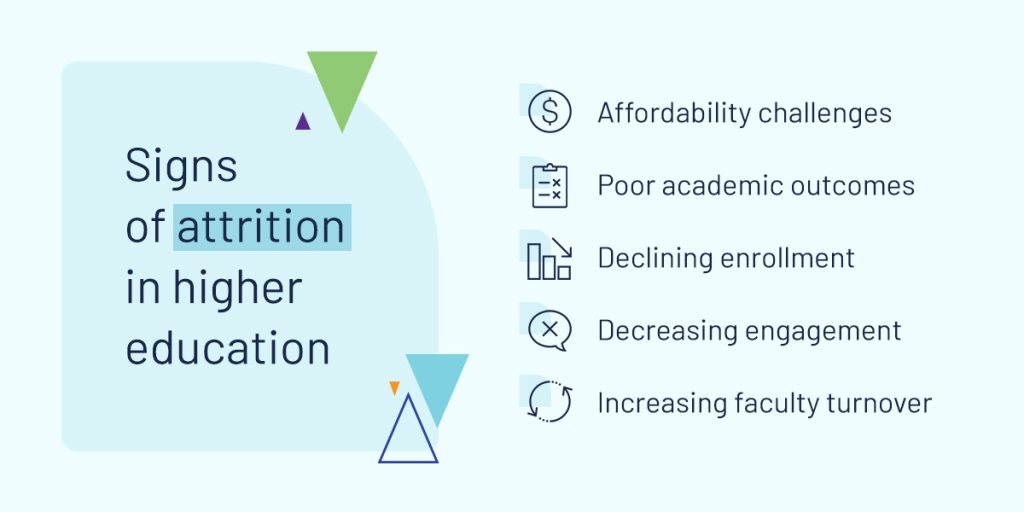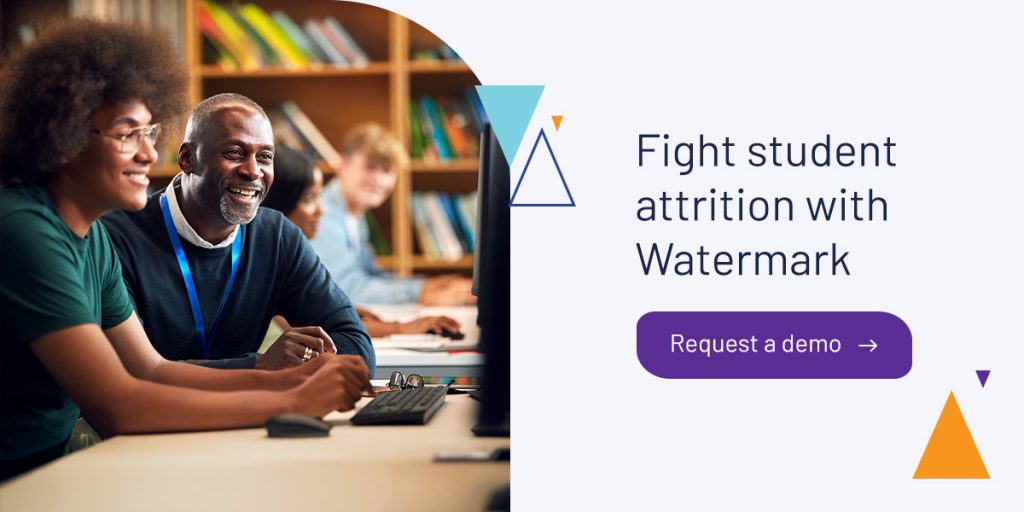
Student retention is fundamental to multiple dimensions of institutional success, from graduation rates to tuition revenue. But many institutions have high student attrition rates, which can hold them back from achieving strategic targets. Nationwide, around a third of students do not complete their degrees on time, within two years of their expected graduation date, or at all.
When students drop out, their prospects and institutional key performance indicators (KPIs) can suffer. These factors make investing in student retention crucial to every higher education institution’s mission. If your institution aims to increase retention, this guide will explain how predictive analytics and other tools can help combat attrition.
What is student attrition?
Student attrition is when students leave an academic program. It can describe situations when students drop out of academics altogether, switch from one program to another, or transfer to another institution. An institution’s student attrition rate is the percentage of students who enroll in a program but do not complete it. Attrition is the opposite of retention, and reducing attrition is a sign of institutional progress.
How does attrition impact higher education institutions?
Student attrition matters as a KPI because of how high attrition impacts institutions, compared to the benefits of increased retention. Rising attrition can lead to:
- Financial losses: When students leave a program, that program loses out on the tuition they would have paid for the remainder of their studies. If students drop out or transfer, the institution also fails to realize a return for its spending on attracting and enrolling those students.
- Reputational damage: The United States Higher Education Act requires colleges and universities to report their retention rates, meaning the public can discover if an institution has high attrition. This can affect perceptions of the institution’s quality and lead to lower rankings on lists of the best places to study.
- Wasted resources: Along with poor returns on recruitment and enrollment spending, high attrition can lead to overspending on academic resources, student accommodation, and other provisions for enrolled students who do not persist.
- Increased workloads: Students who transfer or drop out often require staff to do more work, from administrative support to exit interviews. The higher an institution’s attrition rate, the more work hours faculty are investing in students who will not graduate from their program.
- Reduced graduation rates: The flip side of high attrition rates is low retention and lower graduation rates. When fewer students in a program go on to graduate, that program’s reputation suffers. This can impact the institution’s financial picture and the long-term outcomes of its students.
Signs of attrition in higher education

Anticipating attrition risks is vital for preventing or reducing high attrition rates. When you know the common risk factors, you can intervene to reduce the likelihood of attrition for individual students and at an institution-wide level. Warning signs for student attrition include:
- Affordability challenges: Financial difficulties are among the main driving forces behind rising attrition. Students who are late on tuition payments or fail to pay are more likely to drop out.
- Poor academic outcomes: Falling or failing grades can lead to discouragement, sometimes culminating in students leaving their program. If a course sees a rise in failing grades, a rise in attrition is likely to follow.
- Declining enrollment: Opting not to enroll in a program is an easier decision than transferring or dropping out of it, but many of the same factors that cause enrollment to decline will also cause attrition to increase. If increased competition, affordability concerns, or a shift in public perception leads fewer new students to enroll, current students may soon leave the program for the same reasons.
- Decreasing engagement: Engaged students are investing their time, attention, and effort into their studies, making them less likely to drop out or transfer. Indicators of reduced engagement, like absence from class, neglecting to submit assignments, or limited communication with faculty and peers, can point to a student who may not persist.
- Increasing faculty turnover: If faculty members are leaving the institution, students may leave for the same reasons. Even if the reasons behind faculty turnover do not impact students, the turnover itself tends to do so. Students may leave a program if faculty turnover disrupts their learning experience or results in a loss of mentorship.
How analytics fight college attrition
Predictive and prescriptive analytics are among the sharpest weapons in the administrator’s arsenal for combating attrition. Predictive analytics analyze trends in data points like grades and participation to identify students at risk of dropping out. AI-powered predictive analytics can save faculty time by highlighting students who most need supportive intervention and allowing those interventions to happen sooner. Prescriptive analytics takes the next step by recommending specific interventions, like scheduling an appointment with an academic advisor.
Institutions have harnessed predictive and prescriptive analytics with great success. For example, Texas Tech University increased retention by 2.6 percent over three years by using predictive and prescriptive analytics. Elsewhere, Central Carolina Community College (CCCC) increased retention by 9 percent for full-time students and 18 percent for part-time students from 2012 to 2020.
More ways to combat attrition in education
Along with predictive and prescriptive analytics, other tools for preventing or addressing attrition problems include:
- Personalized learning: Adaptive learning technologies create a more engaging study experience suited to individual learning styles.
- Academic support: Academic advisors and tutors can help students persist through challenges in their coursework.
- Financial aid: Financial aid, merit awards, and payment plans can help solve affordability concerns that contribute to attrition.
- Inclusivity initiatives: Cultivating a campus that embraces diversity and inclusion can promote a sense of belonging among students, improving engagement and retention.
- Peer mentorship: Students can connect with peers through support groups or mentorship relationships that keep them anchored in the student community and encourage persistence.
Fight student attrition with Watermark
The battle against attrition is an essential part of the fight for institutional success. If you want to equip your institution to win this battle, add Watermark Student Success & Engagement to your arsenal.
Watermark Student Success & Engagement is an innovative software solution to support each of your students through every stage of their journey, from prospect to graduate. This industry-leading solution helps your institution:
- Intervene when it matters most with AI-powered predictive and prescriptive analytics.
- Create personalized, guided learning pathways to keep students engaged.
- Provide highly accessible student support through the native mobile app.
Thanks to these advanced capabilities, institutions using Student Success & Engagement have seen a 6 percent improvement in retention in the first year. Request a free demo to see how it can help retain students at your institution.
















































































































































































































































































































































































































